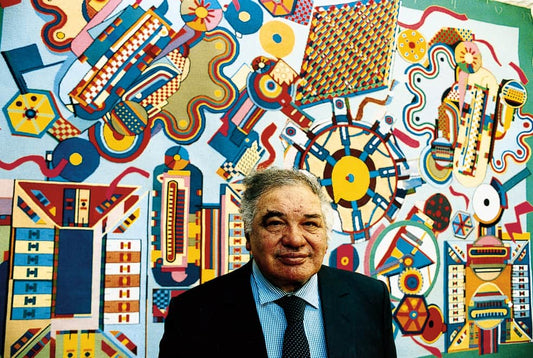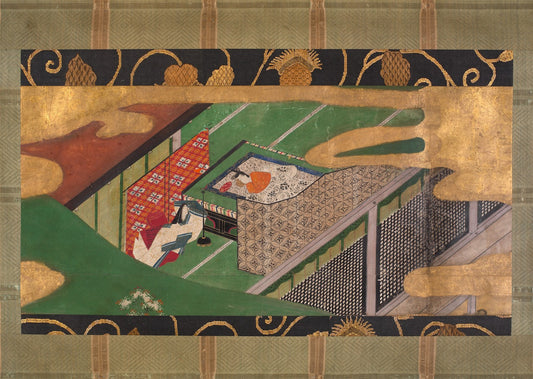Feature image: Marie Mountson, The Anthropology via Saatchi Art
Art & Anthropology - analysis of humanity through the historical bones of society
Art uplifting our anthropological findings of past humans explores what it means to be human by putting the bones of our history on center stage. Some paint the skeletons of our earliest examples of humans within life-like contexts, while some revolve around specific bones found at dig sites.
For example, our earliest complete skeleton of a human provided insight into how our ancestors lived. Still, some anthropologists point to a hypothetical injured femur as the first example of a developing human society—it offered a new element to archeology that focused on how humans experienced life instead of simply survival. The lack of bone discovery makes this so impactful that the idea of it has enamored anthropologists and civilians alike.
The idea of the bone was so impactful for anthropologists and humanity because it was a broken femur that later healed. Knowledge of this skeleton is limited, but its discovery grounded anthropologists for decades. The presence of this is widely speculated, but people use broken femurs in art surrounding anthropology to serve as a symbol for the birth of humanity. Its existence is unproven, and even if we never find that bone, there’s an understanding that there has to be a first time somewhere, whether it be the first time someone healed the wounds of another or the first time a building was constructed. We don’t need the presence of a bone to prove that we had to start somewhere at some point in time.

Art of the first bones of society - Lucy
We will never know her face, but historians and anthropologists worldwide know her name. Lucy was discovered on November 24, 1974, by paleoanthropologist Donald Johanson. As his team excavated her that evening, they listened to the Beatles' "Lucy in the Sky with Diamonds," where they agreed to name her Lucy to immortalize the moment.
Lucy belongs to Australopithecus afarensis species, an extinct hominid species that lived between 3.9 and 2.9 million years ago during the Pliocene and Pleistocene epochs. She lived approximately 3.2 million years ago, and her remains are about 40% complete, making her one of the oldest and most complete hominid fossils ever found. She was a small hominid, about 3.5 feet (1.1 meters) tall. Her pelvis and leg bones indicated that she was bipedal or walked on two legs, a key characteristic in the evolution of humans. Lucy's limb proportions suggest that her legs were optimally adapted for both walking and tree-climbing.

Lucy was critical to archeology and anthropology because she provided evidence of early humans walking upright, challenging previous ideas that bipedalism arose after increased brain size. Her discovery contributed to our understanding of human evolution and the transition from ape-like ancestors to the early members of the Homo genus. She has helped researchers piece together the evolutionary relationships between various hominid species throughout ancient history.
While the original Lucy fossil is stored safely, exact replicas have been crafted to display in exhibitions in museums worldwide, allowing the public to learn about Lucy and appreciate her contributions to understanding ourselves as a species. Even though she is one of the most complete skeletons found, we will never know what she looked like, so artists preserve her memory by making space for her remains in paintings.
One of the first models of humans - Cheddar Man
Usually, models of human skulls remain stone-faced and look straight ahead, emphasizing structure and function. These acknowledge the presence of a human but focus solely on the data at hand to develop the models. Kennis and Kennis Reconstructions took extra time and compassion with his model, giving him a smile and eyes filled with curiosity.

Artists and anthropologists were also interested in the Cheddar Man because he was seen as one of the first humans to have blue eyes. Experts believe blue eyes stem from genetic mutations thousands of years ago. The genetic mutation for blue eyes originated from a single individual somewhere in the Black Sea region. Over time, this genetic trait spread through populations, and today, blue eyes are most commonly found in people of European descent.
Burial of a husband and wife
The ancient man and woman were found buried in a loving embrace in a grave in Ukraine. The skeletons are approximately 3,000 years old. The husband died, but we learned from the woman's bones that she drank poison and was buried alive alongside her lover.
The couple belonged to the prehistoric Vysotskaya culture in Ukraine. Based on previous archeological excavations, the Vysotskaya Culture, also known as Wysocko, is notable for the tenderness of their burials, with other instances revealing couples in various affectionate positions. In this case, however, only half of this couple was laid to rest completely dead. The couple's burial positioned both of their faces gazing at each other, foreheads touching and the woman tenderly hugging the man. The woman's legs were bent at the knees, lying on the man's stretched legs.

Many people debate whether this was done willingly by her or was simply a cultural practice. However, experts believe she went to the grave willingly and is believed to have taken poison before burial. Positioning the couple in this manner would be difficult if both were dead, providing further possible evidence that she chose to be entombed alive to accompany her deceased husband to the afterlife.
Archaeologists speculate that the woman could have chosen this voluntary death to avoid living without her husband or adapting to a new way of life. There is a high possibility that whatever she consumed allowed her to join her husband peacefully and painlessly.
Regardless, the woman died embracing her lover, their bones still holding one another thousands of years after they passed away. The art depicting them doesn’t make them look like they have passed away; it makes them look like they are resting next to each other in bed, their love as eternal as their slumber.

Archeological Anthropologists give us insight into the people we uncover from the earth, and the art produced reflects humanity’s emotional response. The art is reverent, almost as though we are paying respect to very, very distant relatives within the art produced in this manner. Even if we don’t know who these people were, we all still see a little bit of ourselves in them, highlighting how evolutionary changes may occur in people. Still, one thing consistent for us in life is steadfast compassion and connection. We may never find that hypothetical healed femur representing the first signs of compassion and community. Still, one thing is for sure—that same compassion lives on in the art we create of our ancestors.
©ArtRKL™️ LLC 2021-2023. All rights reserved. This material may not be published, broadcast, rewritten or redistributed. ArtRKL™️ and its underscore design indicate trademarks of ArtRKL™️ LLC and its subsidiaries.





